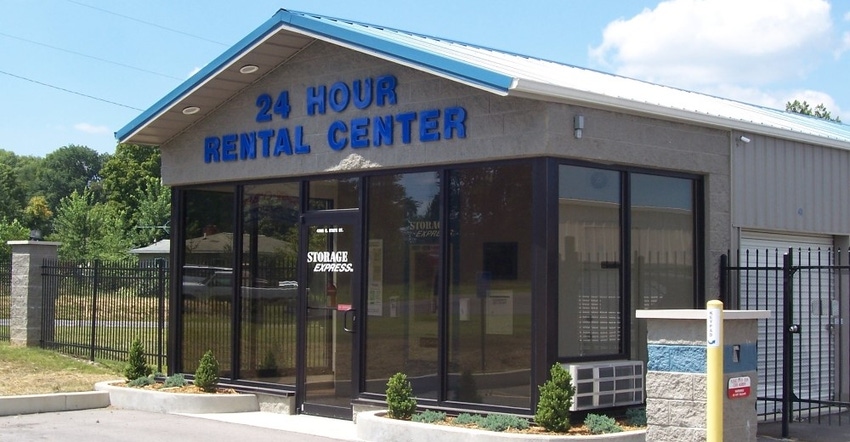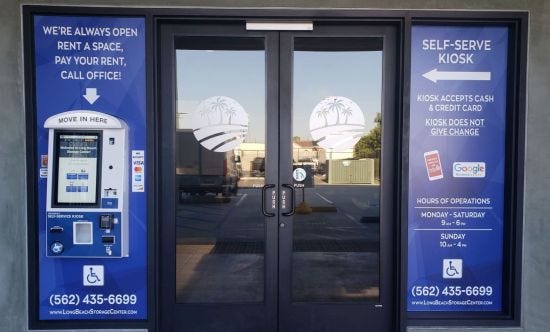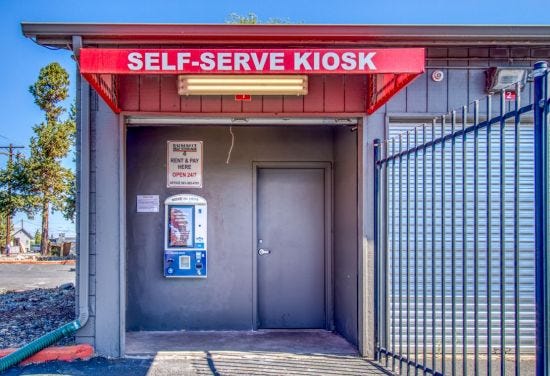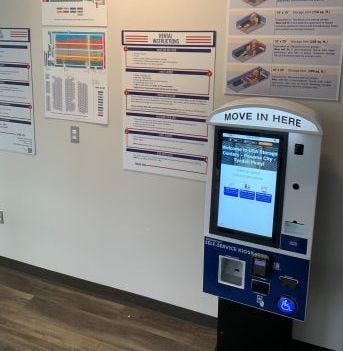Self-service technology is becoming the norm in many industries, self-storage included. Read how a kiosk can be used to better support staff and customers, improve operational efficiency, and give your facility a competitive advantage.

While the idea of an automated operation isn’t new to self-storage, it certainly has become more popular in response to recent health- and labor-related challenges created by the coronavirus pandemic. Facility operators are quickly figuring out they can use technology, including self-service kiosks, to better support staff and customers.
By leveraging the abilities of a kiosk, self-storage managers can remain focused on the most value-creating work activities such as sales, collections and maintenance. The technology not only creates operational efficiency to improve the bottom line, it elevates the customer experience. By providing a full-service rental and payment solution any time of day or night, it has proven to be an invaluable business tool.
Let’s examine important considerations for integrating a kiosk into your self-storage operation, including pros and cons, and best practices to optimize a successful implementation.
Components and Pricing
Self-storage kiosks come in a range of styles, models and prices. They can be customized with a variety of features so customers can use them to select a unit, sign a lease, purchase insurance, buy a lock, pay rent and more. A full-service model should offer options including:
Credit card reader, bill acceptor and ACH capture for multiple payment types
Cloud-based integration with property-management software for real-time updates on pricing and inventory as well as automatic application of rental payments
Digital camera and on-screen recording to document all transactions
Digital signature capture and driver’s license scanner to help verify tenant identity
Two-way, live, bilingual customer support
Many models even support live video chat and remote control, which provides anytime help to customers and makes a kiosk the next best thing to in-person interaction.
When evaluating which kiosk is right for your self-storage facility, consider your budget, the physical limitations of your space, and the features that are most critical to your operation. Also inquire about any long-term software and hardware support offered by the vendor.
The costs associated with kiosk technology vary. When evaluating options, it’s important to understand what’s included in the base price, whether the system was designed to address specific self-storage tasks, and the cost of ongoing service, support and hardware. Some models can start at a low base price but don’t include vital components such as card readers, LCD touchscreens, enclosures, software and management support, etc. They can quickly top $11,000, which doesn’t account for future replacement or product-failure costs. In contrast, all-in-one models built for the self-storage industry range from $6,100 to $16,000, with nominal monthly support fees that cover ongoing cloud-based software updates, live customer support, hardware replacement, warranty and more.
Your most important consideration should be revenue potential. Proprietary data from 2020 indicates top-performing kiosks can return an average of 11.87 rentals per month. That’s an extra $156,684 in annual rental income when assuming an average lease value of $1,100. These figures don’t even include the potential for incremental payment revenue or operational savings.

An example of promotional and directional kiosk signage at Long Beach Storage
Center in Long Beach, California
Advantages
A kiosk can benefit your self-storage operation in many ways. First and foremost, it gives you team flexibility. By making rentals and taking payments, it frees up manager time and allows employees to stay focused on other essential, revenue-driving activities. You can even choose to man your facility only during peak hours. This demand-driven staffing model reduces operational costs and optimizes your human resources.
A kiosk also provides virtual assistance to reduce customer friction across every interaction. The latest technology allows customers to connect to a real person via live video chat, addressing the needs of those who require human intervention. You get to offer live customer service without the need to have a manager physically in the office.
Other improvements in operational efficiency are possible with a self-storage kiosk, too, including:
Extended rental and payment hours, leading to increased sales and fewer delinquencies
Reduced customer wait times
Increased accessibility of service
Greater data accuracy
Ability to cater to customers who prefer technology or want to limit in-person interactions
Drawbacks
While kiosks offer many advantages, it’s also important to consider potential drawbacks, which include the typical concerns associated with self-service equipment, such as theft or vandalism. Here are a few challenges for which to be prepared:
|
Upfront costs. A kiosk will carry initial expenses, but it’s important to consider the long-term return and know how the investment will impact your operation over time. Some vendors offer online calculators to help you estimate how quickly a kiosk can pay for itself and begin adding value to your property.
Technical issues. As with any technology, malfunction is possible. Do your research and invest in well-made products with quality customer support. Are the components plug-and-play, or will they require an onsite tech to fix? Does the company offer real-time software updates, or will your system become obsolete over time?
Human resistance. Some customers will always want in-person service. Your staff may also view a kiosk as an unfavorable addition and be reluctant to promote its use. To combat customer objections, try putting the kiosk near the front desk, so managers can easily help users when necessary. When no employee is available, the live video chat can provide real-time assistance. The agent can even take over the screen to help the customer complete tasks. Help your team see the kiosk as an asset rather than a replacement by highlighting its benefits.
The biggest mistake you can make when integrating a kiosk (other than choosing a low-quality product) is to install it with little thought as to how it’ll be used. To improve its efficacy, consider how it’ll integrate with your operation long before it’s on site.
Best Practices for Adoption
To ensure you get the most out of your kiosk from the outset, take steps to prepare your property, processes and people for its arrival. First, consider where you’re going to put it. You’ll be most successful if you have a dedicated location such as an outdoor enclosure, inner vestibule or a spot next to the office door. The kiosk should be easily visible to incoming traffic and have adequate protection from the elements. Provide good lighting for visibility as well as safety and security. Leave your office lights on after hours to show you’re open for new rentals.
Consider how you want tenants to use the kiosk and create a customer experience around those goals. If you plan to operate 24/7, buy a neon “Open” sign and never turn it off. In fact, signage will play a critical role in adoption. Your kiosk should be clearly identified with promotional and instructional signs throughout the facility. Prominent signage near the road can help you capture drive-by and after-hours traffic as well as tenants who prefer self-service. Also put signs near the gate, outside the main office and within the facility aisles.
|
In addition, place a sign next to or above the kiosk that details what transactions customers can complete and directions for its use. Encourage tenants to complete simple transactions at the kiosk, such as monthly payments, with messages that convey ease-of-use and rapid service. If the kiosk isn’t in your reception area, consider putting directional signage there as well.
Here’s another tip: A printed awning can serve as directional signage and protection from the elements. Messages like “24-Hour Rental Center” or “Rent & Pay Here” can help tenants easily identify kiosk availability.
Aside from all its operational functionality, your self-storage kiosk can be an incredible marketing tool, but you must promote it! Tell customers about the added convenience it provides. Add a photo to your website along with messaging like “self-service kiosk,” “extended office hours” or “move in immediately.” Send out a promotional email and social media posts once it’s available and play up its features. Customize your facility voicemail message or Facebook auto-response to let customers know they can use the kiosk anytime to rent space, even when staff is unavailable.
Facility staff play perhaps the most important role in the success of your kiosk. They should promote it to new and existing tenants as part of their regular routine. They can incorporate it into facility tours, refer tenants to the kiosk for routine tasks when they’re busy with other customers, and walk new tenants through a transaction on the kiosk to make them more comfortable using the technology on future visits.
The value your business will get from a self-storage kiosk is directly related to how well your team embraces this new amenity. Remind them early and often that the technology helps reduce delinquency and collection calls and frees up time to concentrate on more profitable tasks. Most operators find little to no resistance to kiosk adoption when expectations are set early.

Summit Self Storage in Bend, Oregon
Competitive Advantage
The self-storage industry is unique in that you can’t create demand. People typically need storage in response to one of five major life events: divorce, downsizing, death, disaster or dislocation. Since demand can’t be driven by sales tactics or desire, facility operators should be ready to respond when business presents itself. This is where an always-on kiosk can prove the ultimate competitive advantage.
Kimberly Robinson is the creative content manager for OpenTech Alliance Inc., a Phoenix-based provider of technology products and services including kiosks, a call center and access-control solutions. Kimberly is responsible for creation and dissemination of engaging content to create a superior brand experience for OpenTech customers. With more than 12 years in marketing and communications and two in the self-storage industry, she offers design, copywriting and content-marketing expertise. To reach her, call 602.749.9370.
About the Author(s)
You May Also Like







